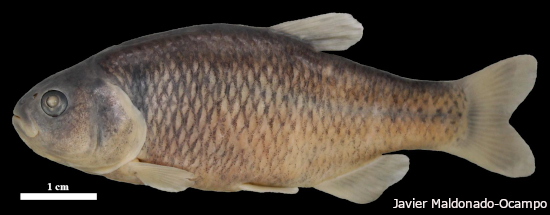| SOURCE FOR OCCURRENCE IN ECUADOR: Barriga (2012), Jimenez et al. (2015). |
| ORIGINAL DESCRIPTION: Román-Valencia, C., R.I. Ruiz-C., and R.E. Barriga-Salazar. 2005. Una nueva especie ecuatoriana del genero de peces andinos Grundulus (Characiformes: Characidae). Revista de Biologia Tropical 53 (3-4):537-544. |
| TYPE SPECIMENS: MEPN 1637. |
| TAXONOMIC STATUS: Valid (Eschmeyer and Fricke, 2020). |
| RANGE ECUADOR: Known only from El Voladero Lagoon in the Biological Reserve El Angel in Carchi Province, northern Ecuador (Jimenez-Prado et al., 2015). |
| RANGE OUTSIDE OF ECUADOR: None. |
| COLLECTIONS IN ECUADOR: MEPN-1637, MEPN-1550, MCNG-53445, IUQ-532 (Jimenez-Prado et al., 2015). |
| MAXIMUM SIZE: Reported to 63.9 mm TL (Valdiviezo-Rivera et al., 2016), common to 42.5 mm (Jimenez-Prado et al., 2015). |
| DISTINGUISHING FEATURES: Relatively deep-bodied, stout characid that lacks an adipose fin and has a strongly curved dorsal profile. Has 12-14 conical teeth. Dorsal fin: ii 8-9, anal fin: iii 11-13, pelvic fin: ii 6, pectoral fin i 12-16 (Jimenez-Prado et al., 2015). Differs from other Grundulus species in having only three simple anal fin rays vs. four or five, only one simple ray in the perctoral fin vs. two-three, and having a greater number of teeth (12-14 vs. 8-10). Also differs in other skeletal details (Roman-Valencia et al., 2005). |
| ECOLOGY: Occurs at a very high elevation lagoon above 3500m where the water temperature is typically between 10 and 17 C. It is worth noting that this is higher elevation than all other native fishes in western Ecuador except species of the Andean catfish genus Astroblepus. Seems to occur in shallow parts of the lagoon that are rich in vegetation where it feeds primarily on small invertebrates, especially cladocerans in the genus Bosmina and chironomids (Insecta, Diptera) (Herrera-Madrid et al., 2020). Valdiviezo-Rivera et al. (2016) found that females between 36.7 and 63.9 mm TL had had an average of 356 eggs (range: 75-716) in their ovaries. |
| ECONOMIC IMPORTANCE: No real economic importance given its small size and limited distribution. |
| CONSERVATION STATUS: Given that it is only known from one small lagoon in northern Ecuador and that predatory rainbow trout have been introduced there, this species is likely highly endangered. A recent survey of the conservation status of the freshwater fishes of Ecuador listed it as vulnerable (Aguirre et al., 2019b). |
| LINK TO FISHBASE PAGE: Click here for link |
| SPECIES PROFILE CREATED BY: Windsor Aguirre |
| SPECIES PROFILE CONTRIBUTORS: Jonathan Valdiviezo-Rivera |
